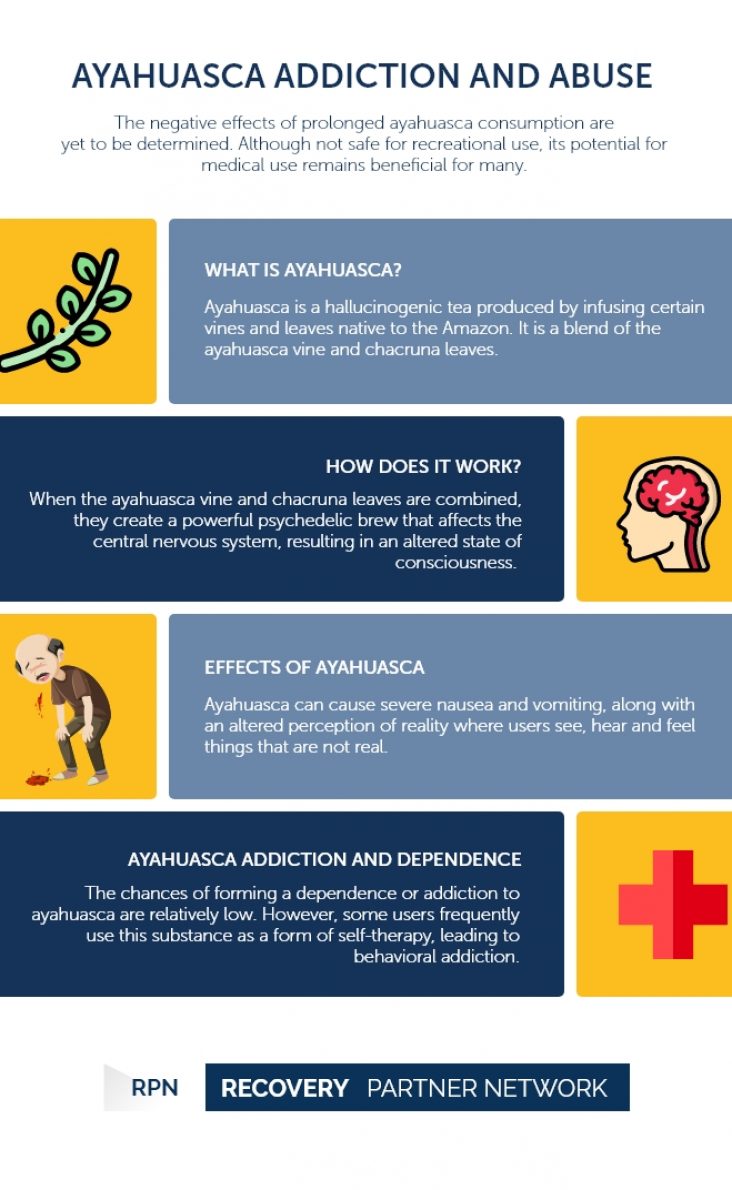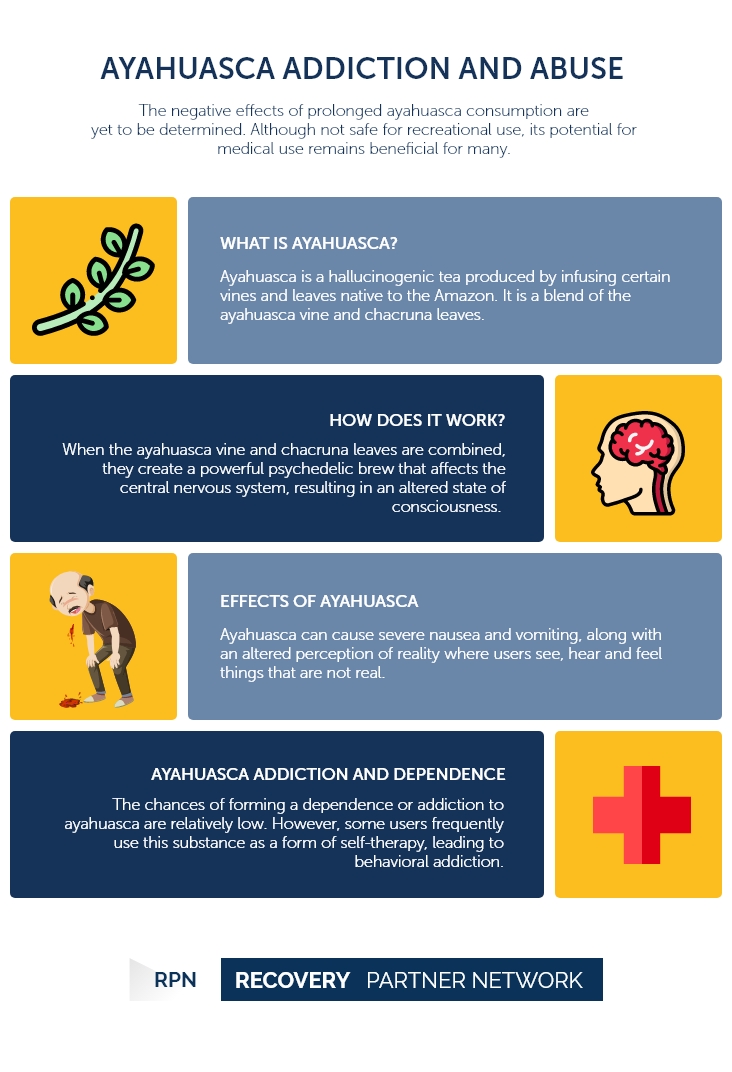The negative effects of prolonged ayahuasca consumption are yet to be determined. Although not safe for recreational use, its potential for medical use remains beneficial for many.
Ayahuasca Addiction and Abuse
Illicit drugs
- Ayahuasca addiction – Abuse
- Baclofen addiction
- Black tar heroin addiction
- Cannabis addiction
- Cocaine dependence
- Crack cocaine addiction
- DMT addiction abuse treatment
- Does Marijuana Kill Brain Cells?
- Ecstasy addiction
- Gabapentin addiction
- gamma-Hydroxybutyric acid addiction
- Hallucinogen
- Heroin addiction
- Illicit drug addiction
- Inhalant addiction
- Cocaine
- Ketamine addiction
- Lysergic acid diethylamide addiction
- Mescaline addiction
- Methamphetamine addiction
- Meth Labs: Cooking up Addiction
- Meth Mouth
- Microdosing
- Phencyclidine addiction
- Psilocybin mushroom addiction
- Sage of the diviners – Addiction
- Shooting Heroin
- Shooting Methamphetamine
- Smoking Cannabis
- Speedball
- Synthetic cannabinoids
Ayahuasca addiction - Abuse | Table of Contents
What is Ayahuasca?
Ayahuasca is a hallucinogenic tea produced by infusing certain vines and leaves that are only native to the Amazon. Although it is sometimes regarded as an illicit drug, ayahuasca is a combination of the ayahuasca vine (Banisteriopsis caapi) and chacruna leaves (Psychotria viridis), neither of which is illegal in the US. These leaves contain dimethyltryptamine (DMT), a psychotropic compound responsible for generating intense hallucinations. Irrespective of the plant that holds this compound, DMT is classified as a Schedule I drug that has a high potential for addiction with no legitimate medical use. Nevertheless, emerging studies reveal that ayahuasca can be beneficial in treating opioid addictions and alcoholism.
The plant was named by the Quechua to mean “vine of the dead” or “vine of the soul.” It typically takes hours to brew the red-brown tea that has an unpleasant, bitter taste. Ayahuasca is also known as Huasca, Yagé, brew, Daime, tea, and La Purga.
FAQ
Ayahuasca is primarily used in religious and cultural rituals. However, ayahuasca is now being utilized as a tool to treat PTSD, sleep problems, pain, cancer, and alcohol and drug addictions.
How Does it Work?
Although the DMT in Psychotria viridis is a powerful hallucinogen, it consists of a low bioavailability as it is quickly broken down by enzymes (monoamine oxidases – MAOs) in the liver and gastrointestinal tract. Due to this fact, DMT must be combined with a substance containing MAO inhibitors (MAOIs) to allow DMT to take effect. Banisteriopsis caapi holds potent MAOIs called β-carbolines that also have their own psychoactive effects. When the vine and shrub are combined, the effects of ayahuasca tea can last anywhere between 4 to 8 hours.
When combined, these two plants create a powerful psychedelic brew that impacts the central nervous system, resulting in an altered state of consciousness that includes hallucinations, euphoria, and out-of-body experience.
How is Ayahuasca Used?
Though ayahuasca has historically been used for various religious and spiritual purposes by certain cultures, it has now become popular among individuals who wish to heal from past traumas or simply undergo an ayahuasca journey.
Individuals who wish to consume ayahuasca are strongly advised to ingest it under the supervision of an experienced shaman, as an ayahuasca trip can result in an altered state of consciousness that can last for many hours, leaving one vulnerable and at risk.
Many individuals travel to countries such as Peru, Brazil, and Costa Rica, where ayahuasca retreats are provided by experienced shamans. Participants of such practices are advised on abstaining from cigarettes, alcohol, drugs, sex, and caffeine before partaking in the ayahuasca ceremony to purify their bodies. Participants may also be advised to follow various diets such as vegetarianism or veganism for 2-3 weeks before the ceremony to free the body of toxins.
FAQ
Ayahuasca and other psychointegrator plants are precious to the indigenous peoples of the Amazon, as well as to the mestizo shamans and followers of the Brazilian churches.
Ayahuasca should not be consumed by those suffering from high blood pressure, cardiac disorder or liver failure. Ayahuasca is known to increase blood pressure; therefore, those who already have high blood pressure or heart conditions are at greater risk of complications.
Potential Benefits of Ayahuasca
Despite the traditions that surround this psychedelic practice, ayahuasca has benefitted many individuals from many walks of life. This compound has proven to be highly effective in treating conditions such as depression and PTSD.
A study published in March 2019 by the National Institutes of Health (NIH) shows the effectiveness of ayahuasca in treatment-resistant depression. The double-blind, randomized trial included 29 patients, some of whom were administered a single dose of ayahuasca and others a placebo. The results reveal that ayahuasca produced significant antidepressant effects in comparison to the placebo.
A hypothesis published in April 2018 highlights ayahuasca’s potential to help treat patients with PTSD. However, more research is being conducted on this possibility.
Several studies have proven the use of ayahuasca in addiction treatment of substances such as alcohol, cocaine, and nicotine. A study published by the NIH in 2014 suggests that the therapeutic effects of ayahuasca helps support recovery and prevent relapses when consumed under carefully structured and monitored settings.
FAQ
Ayahuasca ought to be used with caution by people with a history of anxiety as it can aggravate the condition.
The first clinical trial of ayahuasca for the treatment of depression has seen a quick improvement in the mood of patients with refractory depression, which does not respond to the usual medication, quite quickly.
Effects of Ayahuasca
Most individuals are under the impression that drinking ayahuasca is safe due to its legal nature in the US. Although it is a natural plant-based product, all drugs carry considerable risk, including ayahuasca. Ayahuasca is particularly dangerous as its intensity tends to vary from one batch to another, which has resulted in fatal consequences in some users.
In addition to severe nausea and vomiting, the most substantial effects of ayahuasca use are the out-of-body hallucinations and altered perception of reality that makes users see, hear, and feel things that are not real. Generally, ayahuasca’s effects begin within 30 minutes to an hour after consumption and peak within 1 to 2 hours. The effects of this drug may last between 4 to 6 hours.
Cardiac arrest and seizures can also occur from consuming ayahuasca. Ayahuasca’s interaction with serotonin in the brain is also lethal for users on antidepressants. However, most ayahuasca users have reported experiencing either good or bad “trips” as well as hallucinations that give an impression of near-death experiences.
The immediate physical effects that arise from drinking ayahuasca are greatly negative. For example, vomiting and diarrhea are some of the common immediate physical effects of drinking this tea. These symptoms are extremely common that some people believe they help “purify” the body. Vomiting and diarrhea can also be potentially fatal as they can be exceedingly dehydrating.
Given below are some of the short-term physical effects of ayahuasca:
- Anxiety
- Diarrhea
- Hallucinations
- Feelings of euphoria
- Increased blood pressure
- Increased heart rate
- Increased body temperature
- Paranoia
- Nausea
- Vomiting
Research on the long-term effects of ayahuasca is still being conducted. Some studies indicate that its use is unlikely to disrupt a normal functioning brain. However, most hallucinogens are known to give rise to persistent psychosis and Hallucinogen Persisting Perception Disorder (HPPD), a condition that is characterized by random hallucinations or visual stimulations such as seeing halos around moving objects. Some studies have also found a direct link between psychedelic drugs and the change in brain structure and personality in the user.
FAQ
- Can you die from ayahuasca?
- Is ayahuasca poisonous?
- Why is ayahuasca dangerous?
- How long does an ayahuasca trip last?
- What is an ayahuasca trip?
As the ayahuasca industry in South America continues to flourish, more and more fatalities are recorded.
Similar to psilocybin, ayahuasca itself is not especially toxic.
There are many potential risks associated with ayahuasca, such as respiratory arrest, seizures, coma, severe diarrhea, and vomiting. Another potential side effect of using ayahuasca is serotonin syndrome. People who are on antidepressants are more likely to get serotonin syndrome if they use DMT/ ayahuasca alongside the antidepressants.
After taking ayahuasca, most people begin to experience the effects between 20–60 minutes. The effects are dependent on the dose consumed and continue to last for 2–6 hours.
People who have experienced an ayahuasca trip report feeling a spiritual awakening. This substance generates an altered state of consciousness that includes hallucinations, euphoria, and out-of-body experience.
Ayahuasca Addiction and Dependence
The chances of forming a dependence or addiction to ayahuasca are relatively low. No evidence has yet been brought to light to demonstrate ayahuasca’s capacity to form tolerance. However, these effects do not preclude the development of behavioral addiction. Some users frequently use this substance as a form of self-therapy.
Recovery Partner Network
We aim to educate and empower. If you feel our library of resources does not cover your specific need, reach out to us, and we would be happy to help.
STATISTICS
© Copyright 2024


